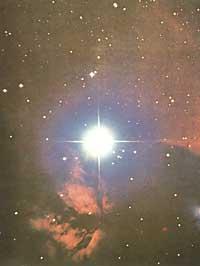Intergalactic shocks (II)
In the previous issue we describe some of the structures seen throughout the sky as a result of intergalactic shocks. However, we do not mention the basis we have for making this claim. Of course, the evolution of a shock is a very long process, and although things happen as we think, we cannot see the whole process, but a situation, like a frame of a film.
The theoretical vision of November began to develop in 1972, when the brothers Juri and Alar Toomre presented the first simulation of a collision of galaxies by computer. In these computer models, galaxies are defined by their mass and shape, using star representation points. However, the mass and gravity field are considered to be concentrated in the center of the galaxy. Although we cannot compare the performance of the computers in which the first model was developed with the current ones, the Toom brothers obtained very encouraging results in terms of usefulness of the method.

With their early work, they demonstrated that some of the most unique structures that can be seen in the sky can be the result of galaxy crashes. For example, simulating the shock of the two simple galaxies, they achieved a stellar distribution very similar to the structure of the galaxy called Antenna Galaxy. Both galaxies seem to be united by the force of gravity, adopting a shape reminiscent of the shape of an insect's head with antennas.
The so-called ring galaxies, for their part, appeared before being seen, as a possible structure thanks to the works of the Toomre brothers. Among these galaxies, the best known is the A0035 or Wheel of the Cart. It appears with centers, radios, sticks. As we said in the previous number, these types of galaxies originate when an elliptical galaxy finds itself in full with the core of a spiral galaxy.
Currently the models of Alar and Juri Toomre have improved a lot. For example, in a relatively new work by Joshua Barnes appear the first models showing galaxies in three dimensions, each expressed in thousands of fractions. On the other hand, this work not only analyzes the shocks of the galaxies that mix, but also those that pass together. For example, we study the behavior of two mass-type galaxies that cross following parabolic orbits (this case is believed to be much more abundant than that of hyperbolic orbits). In this case, it seems that the attraction of gravity causes the galaxy nucleus to exit the plane of the disk and, therefore, the matter of the disk moves out, making approximately a direct route.
Galaxies called Cluster Dominants also have effects of the type of interaction described. These galaxies are very large and have been found in the center of some clusters. That is why they have been named. They occur when two galaxies approach low relative speeds or when one is much higher than the other. Once the galaxies approach and deform they begin to move away, but soon they come closer to submerge and form one of the giant galaxies mentioned. Normally we will talk more in depth about the creation of elliptical galaxies in the following issue.
EPHEMERISSUN : October 23 enters Scorpio at 22h 5min.
PLANETS
|
Buletina
Bidali zure helbide elektronikoa eta jaso asteroko buletina zure sarrera-ontzian











